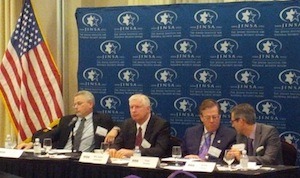New Technologies for the U.S. Army Symposium
On October 18, 2012, JINSA, in conjunction with The Reserve Officers Association (ROA), and the National Defense Industrial Association (NDIA) held a symposium on “New Technologies for the U.S. Army: Future Prospects and Policy Implications.”
On October 18, 2012, JINSA, in conjunction with The Reserve Officers Association (ROA), and the National Defense Industrial Association (NDIA) held a symposium on “New Technologies for the U.S. Army: Future Prospects and Policy Implications.”
As an organization dedicated to supporting a strong American military, JINSA was honored to host discussions relating to new technologies that will prepare the U.S. Army to better address future security challenges. It is our hope that this will be the first of a series of symposia that will address this important issue for each branch of the armed services and the Department of Homeland Security.
 The three panelists and a keynote speaker addressed technologies that are in development to counter emerging threats and changes in future warfare capabilities.
The three panelists and a keynote speaker addressed technologies that are in development to counter emerging threats and changes in future warfare capabilities.
Summary of Presentations:
Peter Huessy (President, GeoStrategic Analysis & JINSA Visiting Fellow) outlined the links between terrorist organizations and their state sponsors and elaborated on the missile threat the U.S. Army will seek to counter.
A possible counter to these threats, Mr. Huessy discussed the capabilities of the JLENS airborne radar system, which provides up to 500km of over-the-horizon detection of incoming threats in the air, on the ground, or at sea. The system could prove vital in congested waterways such as the Persian Gulf and the Straits of Malacca. Of particular concern to the U.S. Navy is the detection of and weapons guidance necessary to counter Iranian swarm attacks involving dozens of small, fast boats.
Mr. Huessy further asserted that JLENS can be used to defend the homeland and American troops against stealth-launched cruise missiles such as those from the Russian Club K container missile system, which is housed in a what appears to be a standard shipping container. Iran and Venezuela have expressed interest in the system.
Huessy urged that JLENS and directed energy systems are two emerging technologies that should be preserved, even in the case of sequestration.
Click here to watch the presentation by Peter Huessy
Retired U.S. Army Major General Galen Jackman affirmed the assertion that cruise and ballistic missile defense should be at the forefront of Army developments. This is due to the rapid proliferation of these weapons among states and non-state actors alike.
Gen. Jackman indicated that the Army is moving toward smaller units and discussed technology that would allow these units, which are operating in ever-larger operational areas, to create “overmatch” over larger enemy forces. To do so in non-traditional theaters, the Army is learning from the Special Operations Forces community. Doing so means promoting defense systems that can protect smaller units against UAV surveillance and attack. UAVs are today possessed by adversary states as well as non-state actors such as Hezbollah.
Click here to watch the presentation by MG Galen Jackman, USA (ret.)
Dr. Peter Leitner of the National Intelligence University took the floor to discuss the proliferation of biological weapons capabilities. He provided intriguing evidence of this threat. Absent an example of a bio-weapon, the proliferation of BSL-4 labs – the highest level of containment – that can handle weapons grade bio-agents such as hemorrhagic fever is evidence that research is ongoing and that bio-arms proliferation could soon become a national security threat.
Dr. Leitner indicated that a possible counter to the biological weapons threat is to increase research on nonspecific immunity that can lead to treatments for hardening the immune systems of people; similar to the way electric grids are hardened against electromagnetic pulse.
According to Leitner, preserving the current technology for the Army is not sufficient – the U.S. must develop new technologies for these threats. An example of important ongoing research is dynamic armor: cloth-like materials that harden to armor-like protection at the point of impact from a bullet or shrapnel. In other words, flexible and light materials that offer the same or greater protection than the heavy, rigid ceramic plates used in traditional body armor.
Ongoing research and development is essential because America’s enemies shop for disruptive technologies and exotic weapons all over the world, some of which could be more advanced than what is being used by U.S. forces because of the U.S. government’s slow acquisition and adaption process.
Click here to watch the presentation by Dr. Peter Leitner
Peter W. Singer, Director of the 21st Century Defense Initiative at Brookings gave the keynote address. Dr. Singer stated that key trends in technology can predict future military programs and needs. He also noted, however, that important trends to consider are finance/budget trends and trends in civilian electronic capabilities.
Dr. Singer also noted that, like the private sector, the military has to prepare for a new generation of soldiers. Future soldiers will need technology that feels intuitive just like the commercial products that they have used their entire lives before joining the military. An example are operator’s controls for the latest defense systems that are modeled after video game controls with which most young persons today are already familiar.
Another example of a future technology that Dr. Singer believes will have a tremendous impact is 3D printing, where one can easily manufacture their own UAV or gun components with just a computer, specs, and a 3D printer. Dr. Singer also emphasized human computer integration, where human enhancement means that soldiers can be equipped with technology that delays exhaustion, increases strength, or enhances the processing of information. According to Dr. Singer, it is “technology that is like Captain America and Iron Man combined.”